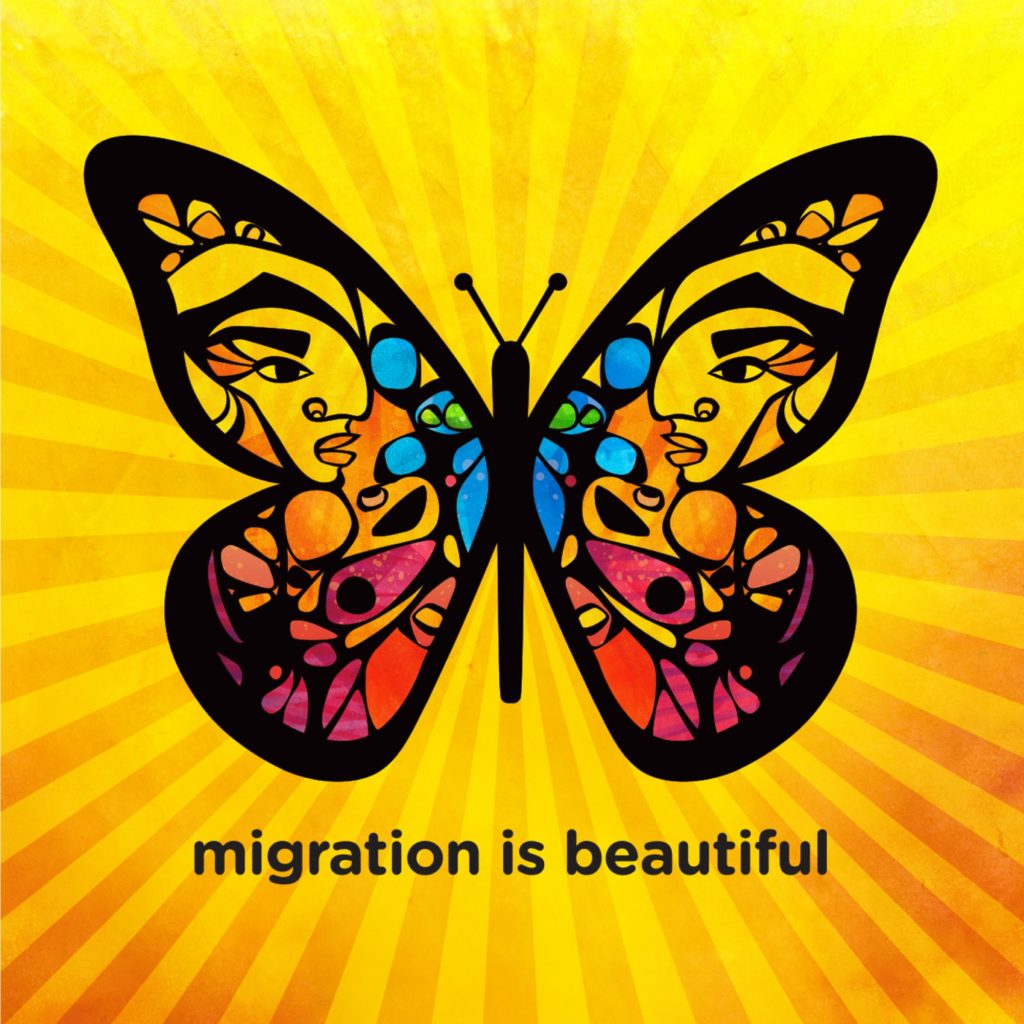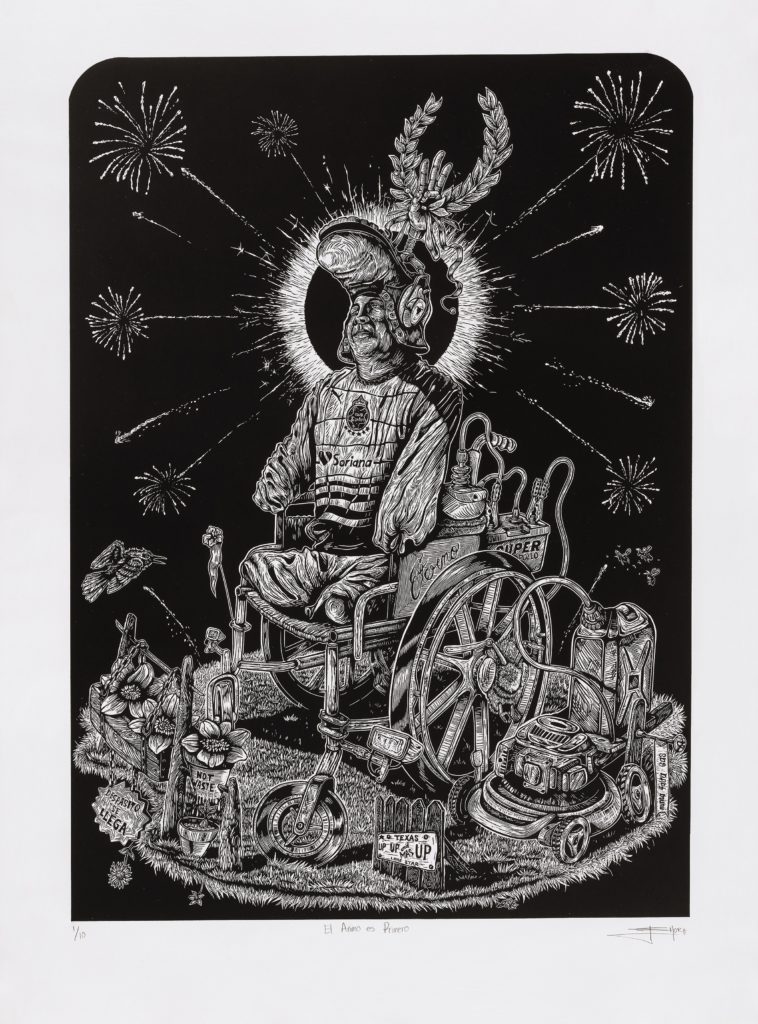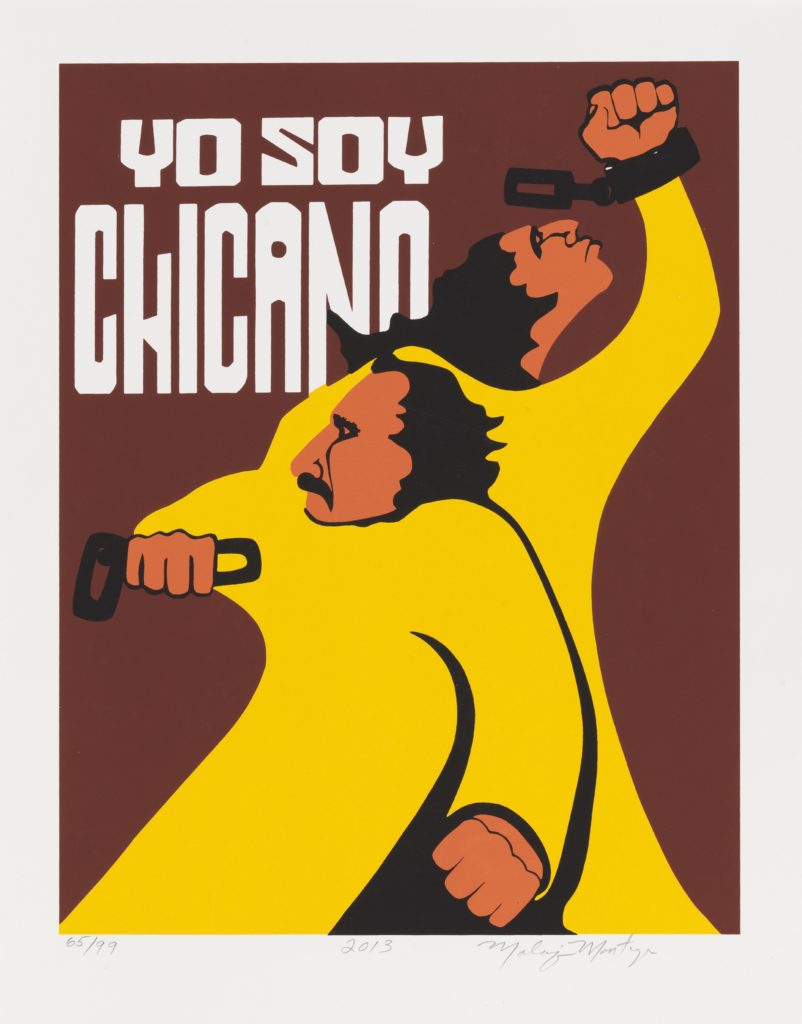The Carter Presents ¡Printing the Revolution! The Rise and Impact of Chicano Graphics, 1965 to Now
In the 1960s, Chicano activist artists forged a remarkable history of printmaking rooted in cultural expression and social justice movements that remains vital today.

The exhibition ¡Printing the Revolution! The Rise and Impact of Chicano Graphics, 1965 to Now presents, for the first time, historical civil rights-era prints by Chicano artists alongside works by graphic artists working from the 1980s to today. On view at the Amon Carter Museum of American Art (the Carter) February 22 through May 8, 2022, it considers how artists innovatively use graphic arts to build community, engage the public around ongoing social justice concerns, and wrestle with shifting notions of the term “Chicano.” Mexican Americans defiantly adopted the term Chicano in the 1960s and 1970s as a sign of a new political and cultural identity. Graphic artists played a pivotal role in projecting this revolutionary new consciousness, which affirmed the value of Mexican-American culture and history and questioned injustice nationally and globally.

Favianna Rodriguez, Migration Is Beautiful, 2018, digital image, Smithsonian American Art Museum, Museum purchase through the Julia D. Strong Endowment, 2020.38.3, © 2020, Favianna Rodriguez
¡Printing the Revolution! includes 119 works, ranging from traditional screenprints to digital graphics and augmented reality (AR) works to site-specific installations, by more than 74 artists of Mexican descent and other artists who were active in Chicanx networks. All of the artwork on view are part of the Smithsonian American Art Museum’s permanent collection of Latinx art, one of the leading national collections of its kind and one of the most extensive collections of Chicanx graphics in an American art-focused museum.
“The Carter is thrilled to be able to bring such an important, landmark collection of Latinx art to our North Texas community,” said Andrew J. Walker, Executive Director at the Carter. “With historic and contemporary work that deeply resonates with social issues w
The artists in the exhibition use graphics as a vehicle to debate larger social causes, reflecting the issues of their time period, including immigrant rights, opposition to the Vietnam War, the civil rights movement, and the Black Lives Matter movement. Vibrant posters and images announced labor strikes and cultural events, reimagined national and global histories, and, most significantly, challenged the invisibility of Chicanos in U.S. society. The exhibition offers an expanded view of American art and the history of graphic arts, featuring previously marginalized voices from Chicano art, including women and LGBTQ+ individuals. The influential Chicano graphics movement has been largely excluded from the history of U.S. printmaking. ¡Printing the Revolution! challenges this historical sidelining of Chicanx artists and their cross-cultural collaborators.
“It’s a special opportunity to host ¡Printing the Revolution!” said Spencer Wigmore, Associate Curator of Painting, Sculpture, and Works on Paper and curator of the Carter’s presentation. “The exhibition sheds new light on the aesthetic and political impact of the Chicano graphics tradition from the 1960s to the present day, while simultaneously emphasizing the urgency and vitality of contemporary Chicanx practice.”

Juan de Dios Mora, El Animo es Primero (Encouragement Is First), 2018, linocut on paper, Smithsonian American Art Museum, Museum purchase through the Frank K. Ribelin Endowment, 2019.35.4, ©2019, Juan de Dios Mora
¡Printing the Revolution! includes iconic works by major artists like Rupert García, Malaquias Montoya, Juan Fuentes, Ester Hernandez, Yolanda López, members of the Royal Chicano Air Force collective (RCAF), and later generations working after the height of the civil rights era. The exhibition features works produced at major print centers, organizations, and collectives located in cities across the U.S., including Austin, Texas; Chicago; Los Angeles; New York City; Sacramento, California; San Francisco; Santa Fe, New Mexico; and Oakland, California. The exhibition is the first to consider how Chicanx mentors, print centers, and networks collaborated and nurtured other artists, including multigenerational stories like that of Chicana artist Yreina D. Cervántez, who mentored her student Favianna Rodriguez, born to Peruvian immigrants in Oakland. Rodriguez herself would go on to mentor digital artist Julio Salgado, a Mexican-born artist and DACA recipient, who is well known for his work exploring the intersection of LGBTQ+ and immigrant rights.
The 74 artists featured in the exhibition are Lalo Alcaraz, David Avalos, Jesus Barraza (Dignidad Rebelde), Francisco X Camplis, Barbara Carrasco, Leonard Castellanos, René Castro, Melanie Cervantes (Dignidad Rebelde), Yreina D. Cervántez, Enrique Chagoya, Sam Coronado, Carlos A. Cortéz, Rodolfo O. Cuellar (RCAF), Alejandro Diaz, Dominican York Proyecto GRAFICA (Carlos Almonte, Yunior Chiqui Mendoza, Pepe Coronado, iliana emilia garcía, Scherezade García, Reynaldo García Pantaleón, Alex Guerrero, Luanda Lozano, Miguel Luciano, Moses Ros-Suárez, René de los Santos, Rider Ureña), Richard Duardo, Roxana Dueñas, Shepard Fairey, Ricardo Favela (RCAF), Sandra C. Fernández, Juan Fuentes, Eric J. García, Max E. Garcia (RCAF), Rupert García, Ramiro Gomez, Daniel González, Héctor D. González (RCAF) , Luis C. González (RCAF), Xico González (RCAF), Ester Hernandez, Nancypili Hernandez, Louis Hock, Nancy Hom, Carlos Francisco Jackson, Luis Jiménez, Carmen Lomas Garza, Alma Lopez, Yolanda López, Linda Zamora Lucero, Gilbert “Magu” Luján, Poli Marichal, Emanuel Martinez, César Maxit, Oscar Melara, Michael Menchaca, José Montoya (RCAF), Malaquias Montoya, Juan de Dios Mora, Oree Originol, Amado M. Peña Jr., Zeke Peña, Favianna Rodriguez, Sonia Romero, Shizu Saldamando, Julio Salgado, Jos Sances, Herbert Sigüenza, Elizabeth Sisco, Mario Torero, Patssi Valdez, Xavier Viramontes, Ernesto Yerena Montejano, and Andrew Zermeño.
¡Printing the Revolution! The Rise and Impact of Chicano Graphics, 1965 to Now is organized by the Smithsonian American Art Museum with support from Michael Abrams and Sandra Stewart, The Honorable Aida Alvarez, Joanne and Richard Brodie Exhibitions Endowment, James F. Dicke Family Endowment, Sheila Duignan and Mike Wilkins, Ford Foundation, Dorothy Tapper Goldman, HP, William R. Kenan Jr. Endowment Fund, Robert and Arlene Kogod Family Foundation, Lannan Foundation, and Henry R. Muñoz, III and Kyle Ferari-Muñoz. Additional significant support was provided by the Latino Initiatives Pool, administered by the Smithsonian Latino Center.
A free, daylong celebration of ¡Printing the Revolution! The Rise and Impact of Chicano Graphics, 1965 to Now is scheduled for April 23. Visit cartermuseum.org for more details closer to the date of the event. Additional events for adults and families will consider the themes and topics of the exhibition throughout the course of the exhibition.

Malaquias Montoya, Yo Soy Chicano, 1972, reprinted in collaboration with Dignidad Rebelde 2013, screenprint on paper, Smithsonian American Art Museum, Gift of Gilberto Cárdenas and Dolores García, 2019.51.1, © 1972, Malaquias Montoya
Note about terms: The Museum uses the term “Chicano” to refer to the historical Chicano movement in the United States (starting roughly in 1965) and its participants. “Chicana” references women who fought for and prefer this designation. “Chicanx” is a current, inclusive designation that is gender-neutral and non-binary.


 Sign in
Sign in

